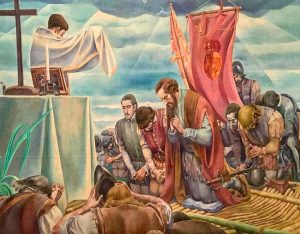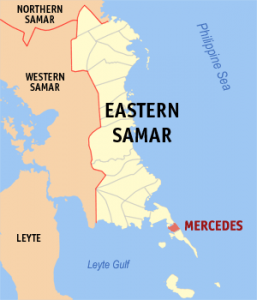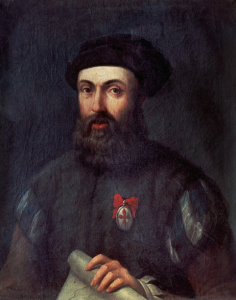The Hospitable Shores of Samar During Magellan’s Landfall
The Hospitable Shores of Samar During Magellan’s Landfall

The first mass in the Philippines
By Charo Nabong-Cabardo
To commemorate the 500th anniversary of the arrival of the Spanish expedition led by Ferdinand Magellan, the Spanish training ship Juan Sebastián Elcano will arrive in Suluan and Homonhon Islands of Samar this March to reenact the World’s first Circumnavigation — one of the most significant achievements in human history.
To recall the even, it took three years after Ferdinand Magellan left Seville, Spain on August 10, 1519, with a fleet of five ships (San Antonio, Concepcion, Santiago, Victoria and Trinidad) to achieve this feat. But then, of the five ships, only Victoria was able to complete their circumnavigation of the world, arriving in Seville on September 9, 1622. (Four months earlier San Antonio which deserted the expedition in April 1522 had arrived in Spain.)
Of the 237 men that accompanied Magellan, only 18 survived the voyage that has been hailed as the first circumnavigation of the globe. They had also fulfilled their mission, finding the western route to Moluccas, the “Spice Island.” Moreover, it had planted the banner of Christianity in the Philippines. Many recognize that the triumph of Magellan’s expedition has provided the “empirical evidence” that the world is round.
Fortunately, one of the survivors was the expedition’s chronicler, Antonio Pigafetta. If he did not survive the voyage, we would not have a more detailed story of this long, perilous but amazing voyage. While there were other accounts by a Genoese pilot of the voyage, another by a Portuguese companion of Duarte Barbosa (brother-in- law of Magellan, also killed in Cebu), and by Francisco Albo, a pilot who kept a log book of the voyage, it was Pigafetta’s account that was the principal account which had more details of the expedition.This is the account of ther arrival and stay in the island of Homonhon in Samar. Today, Homonhon is an island barangay of the town of Guiuan in the province of Eastern Samar.
 From Seville, Spain, it took Ferdinand Magellan, more than a year to navigate this western route along Africa, South America and finally on November 28, 1520, they began their journey through the Pacific Ocean and sailed through this sea for three months and 20 days. The sea was so calm, they did not even encounter any storm, that they named the ocean “Pacifico,” (Spanish for peaceful).
From Seville, Spain, it took Ferdinand Magellan, more than a year to navigate this western route along Africa, South America and finally on November 28, 1520, they began their journey through the Pacific Ocean and sailed through this sea for three months and 20 days. The sea was so calm, they did not even encounter any storm, that they named the ocean “Pacifico,” (Spanish for peaceful).
During those three months, they did not see any land from which they could get provisions, thus they suffered from hunger and thirst. Many had died and still many had succumbed to scurvy. Antonio Pigafetta narrated:
“Wednesday, the twenty-eighth of November, 1520 . . . we entered into the Pacific sea, where we remained three months and twenty days without taking in provisions or other refreshments . . .We ate biscuit which was no longer biscuit, but powder of biscuits, swarming with worms, and stank . . . strongly of the urine of rats. We drank yellow water that had been putrid for many days. We also ate some ox hides . . . which had become exceedingly hard because of the sun, rain and wind . . . often we ate sawdust from boards. Rats were sold for one-half ducado apiece and even then we could not get them. But above all misfortunes, the following was the worst. The gums of both the lower and upper teeth of some of our men swelled, so that they could not eat under any circumstances and therefore died. Nineteen men died from that sickness (scurvy). Twenty-five or thirty men fell sick in the arms, legs or in another place, so that but few remained well.”
At dawn of Saturday of March 16, 1521, the expedition of Ferdinand Magellan came upon an island called “Zamal” (Samar).

ERDINAND MAGELLAN
Credit: biography.com
In his chronicle, Pigafetta said that their previous experience ten days before, in what is now Marianas Islands made them wary of landing on the big island of Samar. When they arrived in the Marianas islands on March 6, the inhabitants of the island boarded their ships and “stole whatever they could lay their hands on . . . and also stole the small boat tied to the flagship, Trinidad. Angered, Magellan sent 40 armed men to the shore and burned about 50 houses and killed seven men.” Having recovered the small boat and got some provisions, they immediately left the island. They called the island, Ladroni (meaning an island of robbers).
With this previous eventful encounter with the natives of Ladroni, Magellan “desired to land on another island which was uninhabited . . . to get water and have some rest.” This was the neighboring island of Humunu or Homonhon.
They disembarked in Homonhon on March 17 and pitched two tents on the shore for the sick and had a pig killed for them. The following day, March 18, a Monday, a boat arrived with nine men on it led by their chief. Magellan was again wary. He ordered that no one should move or speak without his permission.
When the natives reached the shore, the leader approached Magellan with signs of joy at their arrival. While five of the men remained with Magellan, the others called on the others who were fishing.
Pigafetta wrote that Magellan “. . . seeing that they were reasonable men ordered food to be set before them and gave them red caps, mirrors, combs, bells, ivory, bocasine and other things.” The natives, in turn, presented Magellan with fish, a jar of uraca (palm wine, probably tuba)), bananas of various sizes and two coconuts. According to Pigafetta, since they had nothings else with them, the natives made signs with their hands that they will be back in four days with umay or rice and coconuts and other food.
In 1934, a document was published in the Philippine Magazine, No. 8, written by Percy Hill, a historical writer. This document related to the landing of Magellan in Homonhon. The document was found sometime in 1867 among the civil archives in an old building on Calle Postigo in Intramuros. A Spaniard, Gil Piamontes de Alazerna had found an old chest, closed with an oxidized padlock which bore an inscription: “Opus Excellentisimus Alfonsus Faxardus Tenzae Gobernatum Philipinum Insularium Diversae Et Venales Res.” The documents in the chest belonged to Governor General Alfonsus Faxardo (of the Royal Audiencia who was the Governor General of the Philippines from 1618 to 1624). Among the documents was a document relating to the voyage of Magellan, entitled, “A Hitherto Unpublished Document on the Landing of Magellan at Homonhon.”
The document narrates that on March 17, while still anchored, Magellan was visited by several canoes or praus, carrying the chiefs of Suluan named Inaroyan, Limbas, Bucad, Layong, Calipay, Badiao, Cabuling and their datu, Garas-Garas. They boarded the ship of Magellan and Magellan explained to them through his interpreter, Enrique, that their King of Spain sent them to spread the Faith of Christ and convert them to the true religion. They also listened as Magellan told them of their encounter at the land of the Landrones. Garas-Garas replied that the chief of that island was named Tilic-Mata and was not a friend of theirs and that their group of Datu Garas-Garas were not their enemy and invited Magellan ashore and accept his hospitality.
Afterwards, the Spaniards disembarked, pitched their pabellons (tents) and “those suffering from scurvy were benefited by eating coconuts and other fruits and vegetables.” Garas-Garas also provided the party of Magellan with large quantities of fish.” As they were so well received, Magellan called the island, Nueva Providencia.
The following day, (March 18) Datu Garas-Garas presented two large jars of rice, a bamboo tube full of honey, pigs, fowls, fruits, vegetables especially eggplants, and a gold headed truncheon. Magallanes refused the gift of the truncheon, saying that it was of too much value. He gave Garas-Garas a pearly colored mantle of wool, a purple hat, some shirts of merino, Toledo knives, mirrors and silver buttons. Garas-Garas divided the gifts among his people and brought out a jar of tuba in which they drank to each other’s health.
They also agreed to celebrate a treaty of friendship. Garas-Garas, Inarayon and their followers, Iros, Cauong, Bulit, Ulasi, Tipot, Calang-Calang, Ugay, Ananiot, and Sicsican representing the Suluans and Captain Hernando Magallanes, Esteban Gomez, Pedro Valderama, Juan Bautista Ponferrol, Gonzalo Gomez de Espinosa and Francisco Albo, representing the interests of His Majesty entered a covenant of peace dated March 19, 1521 with Leon de Espeleta as the notary:
“That there shall be peace between both parties and that the party of the second part promises to defend and protect the natives from all their enemies so long as this covenant lasts;
“That the products of land and sea be subject to the laws of trading, that the women be respected, and abuses by either party be punished by each respective chief;
“That the natives render aid to the subjects of His Majesty in both peace and war, and that the vessels of His Majesty if they arrive shall be supplied with provisions at the current price;
“That if either party transgress this treaty of peace they shall be punished by laws of either chief and that if attacked by any enemy they shall united to defend their interests.”
While we really cannot now ascertain the authenticity of the document, the narration is similar with that of Antonio Pigafetta. Both established the fact that the natives of Suluan Island were, no doubt, friendly and hospitable. The difference lies in the details provided in this document – the names of the Suluan chiefs, the gifts presented by both sides. The difference in dates can be explained by the International Dateline reckoning.
Pigafetta wrote that the natives (unnamed in his account) returned after four days, as they have promised, on March 22. They came in two boats with coconuts, sweet oranges, a jar of palm wine, and a cock (“to give us to understand that they had poultry in their country,” so said Pigafetta). They came with their “seignour” who was an old man with his face painted (tattooed) and wore long gold earrings, bracelets, gold armbands and a pudung on his head.
This encounter between the Spanish expedition and the Suluans of Samar Island gave us a glimpse of the cultures of both countries. Magellan and party saw that Samar already had a structured society lead by the datu and had a tradition of tattooing, a culture of adornment and a culture of fishing. A hundred years later when the Spanish missionaries arrived in Samar, Jesuit missionary/historian, Fr. Francisco Alcina, began documenting this tradition of tattooing in Samar Island, to mark the passage of boys into manhood. And only when a man has done a brave feat that he is allowed to add a mark/tattoo to his skin. Fr. Alcina also documented that Samarnon society then was already structured according to social classes which dictated not only the behavior of men and women but also the manner of dressing from head to toe, from cradle to their graves.
The Captain General, Ferdinand Magellan, on the other hand, showed the natives of Suluan all his merchandise – cloves, cinnamon, pepper, ginger, nutmeg, mace, gold and all the things in the ship. He showed the might of the Spanish arms, he fired mortars for them and the Suluans showed “great fear, and tried to jump out of the ship.”
In the eight days that Magellan’s party was in Homonhon, the people of Suluan became familiar and friendly with them and they told the Spaniards their names, the names of their island, names of the other islands, the things that could be seen there. Pigafetta wrote, “We took great pleasure with them for they were very pleasant and conversable.” He also remarked that the natives took their leaves “very gracefully and neatly.”
They learned that on a nearby island, the people had darts, daggers and knives ornamented with gold, harpoons and nets to fish. They also learned about the coconut – how they extracted the tuba, and how they made vinegar and oil and that the coconut had a first husk colored green, with threads made into cords for their boats, the thicker husk is burned made into a powder; then the meat which like bread eaten with their fish and can be dried; then the middle marrow with sweet water and congeals like an apple, (which Samareños called the bu-ay).
They learned the name of the island was Humunu (Homonhon) and that the people came from Zuluan (Suluan). Magellan went ashore everyday and tended to his sick men with juice of the coconut which they found “refreshing” and greatly “comforted” them.
Magellan named Homonhon the Acquada da li buoni Segnialli, or the Watering Place of Good Signs because they found two springs with “clearest water.” They would call the islands “Islas de San Lazaro” as they discovered them on the day of St. Lazaro.
On the 25th of March, they went on with their fateful journey to Limasawa, to Cebu and Mactan where they encountered friendships and hostilities. In Mactan, Ferdinand Magellan met his tragic fate.
There is no doubt about the hospitable shores of Samar and the friendly people of Suluan. And today, as we launch the quincentenario of Magellan’s voyage, the people of Guiuan, to which the islands of Homonhon and Suluan belong, are preparing to celebrate this friendship between the Philippine and Spanish nations.
But wait, after 500 years, a question still lingers. In the eight days that Magellan was in Homonhon, was there never a mass celebrated? After spending 120 days sailing the Pacific ocean in hunger and thirst, reduced to eating rats, and even ox hides used for rigging and drinking putrid water, after encountering hostile natives in what they called Ladrones, would they not have been thankful that they were delivered from a calamitous situation when they landed in Homonhon?
Pigafetta had narrated that Magellan and party religiously went to mass as much as they could. When they arrived in San Lucar from Seville, Pigafetta reported that “everyday we went ashore to hear mass.” When they arrived in “Verzin” (Brazil) after two months travelling the coast of Africa and South America, again Pigafetta reported that “mass was said ashore.” Leaving the port of San Julian at the tip of South America, where they stayed for five months, Magellan and all his crew made their confessions and received communions.
A priest, Fr. Pedro de Valderrama, had survived the voyage with them. Fr. Cantius Kobak, historian and translator of Fr. Francisco Alcina’s monumental book, Historia de las Islas e Indios de Bisayas, 1668, had argued that “no mention of the Mass or other public acts of worship was made in historical writing does not imply an absence of the ritual or denial of its celebration. Also, there is no apparent reason why Mass would have not been celebrated daily; what more, on a Solemn and a Glorious feast as “Palm Sunday” and initiating Holy Week. Finally, perhaps Pigafetta was so pre-occupied with all the newness, differentness, strangeness and the great joy of respite on the island with spring waters, captivating visitors from the neighboring Islet of Suluan, that the common, the ordinary events did not catch his attention. Besides, as an Italian, he was not too religious. Hence, unrecorded, non-chronicled `First Masses’, if you will, were offered near (aboard the ships) Humunhon Island. Father Pedro de Valderrama was the only chaplain now with the Fleet; there was no mention that he was ill.”
Pigafetta narrated that “Early on the morning of Sunday, the last day of March, and Easter-day, the captain-general sent the priest with some men to prepare the place where mass was to be said . . . When the hour for mass arrived, we landed with about fifty men, without our body armor, but carrying our other arms, and dressed in our best clothes.” Pigafetta did not exactly say that it was their first mass, he only reported that a mass was celebrated on Easter Sunday.
There is still a raging debate where the first mass was celebrated, in Limasawa? or in Mazazua (Butuan)? But the Samarnons have not engaged in these debates, for we believe that the first masses were celebrated in Homonhon in thanksgiving for their deliverance from hunger and thirst when they finally arrived at an island that was hospital to them. In an age when the world has yet to be explored and an understanding was yet to be reached among peoples, the Suluans/Samarnons have shown goodwill and hospitality to strangers.
—————————–
References:
Albo, Francisco, The First Voyage Round the World/ Log Entries; Hill, Percy, A Hitherto Unpublished Document on the Landing of Magellan at Homonhon, Philippine Magazine, August 1934;Kobak, Cantius, “Enrique de Malacca: A Tribute to the Philippine Bisayan Who Circumnavigated the Globe with Magellan.” Philippine Sacra, Vol. XXXIX, 2004; Pigafetta, Antonio, First Voyage Around the World in Philippine Islands translation by James Alexander Robertson, Vol. XXXIII, The Philippine Islands, 1493-1898; Transylvanus, Maximilianus, De Moluccis Insulis, in Philippine Islands in Blair and Robertson, Vol I.
—————————–
(Charo Nabong-Cabardo hails from Samar and is the co-editor/writer of coffeetable books, O Catbalogan; Calbayog; Diocese of Calbayog: 100 Years; Karasa, Celebrating the Culinary Traditions of Catbalogan; Mga Retrato han Akon Bungto at iba pang Akda, a collection of poems by Iluminado Lucente, published by the Commission on Filipino Language)
Comments (0)